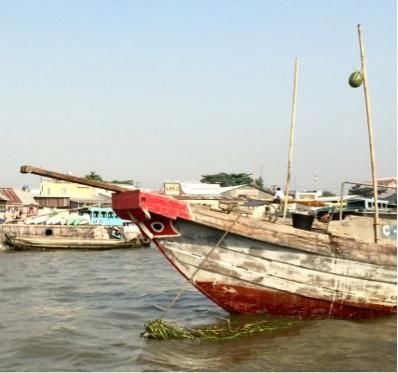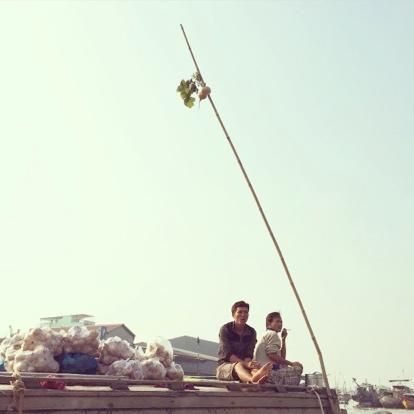
A Floating World
Nina Hien
“Everything is negotiable” became the smiley refrain of our tour guide, Huy, as he explained how things operate here as we winded our way down the S-shaped of Vietnam. This phrase suggested a fluid attitude and a flexible mode of interaction in a place where the word for “country” is literally nước (“water”).
This method of maneuvering became strikingly visible to us upon arrival to the Mekong Delta, deep in the southern part of the country. Appropriately, this fertile constellation of waterways is named after the most powerful, mysterious, mythical and serpentine-shaped creatures related to water—dragons. Sông Cửu Long (“Nine Dragon River”) is a liquid maze of winding tributaries welcoming all kinds of travelling characters—tourists like us, locals, traders, merchants, workers—drifting or cruising on this vessel or that. Early in the morning, many of the boats are on a mission to the Cái Răng wholesale market, passing rampant clusters and colonies of lavender-blooming water hyacinth and endangered mangrove forests on the sides protecting the banks of the river from erosion.
The Cái Răng market floats close to Vietnam’s fourth largest city, Cần Thơ, which, following its name—an abbreviation of “River of Poems”—has a rhythmic and romantic personality. As the Vietnamese saying goes: “Cần Thơ, white rice, pure water. All who come, wish never to leave.” Rice and water are the basic substances of life here.
Here at this liquid marketplace, one could funnily say that networking is also a sort of “wetworking.” Through all the animated exchanges and negotiations occurring, the market epitomizes and elucidates the interconnecting flows of matter and material existence in the country. Food vendor sampans cozy up to vessels offering passengers breakfast soups and stews to slurp, coconuts and fruit drinks to sip and tasty snacks to swallow. At the same time, merchants on other crafts unload bushels and tons of wholesale fruits and vegetables and locally made goods onto buyers’ boats, some of which will head to distant places.
Many of the boats here are painted with pairs of protective eyes that also attract customers with their openness and humanization.

We witnessed in awe and amusement how the vegetable sellers advertised their goods by suspending clusters of their specific product high into the sky on bamboo poles. Despite the constant movement and exchange of products, there is also a lot of hanging out going on here.

In this region, beyond a lively aquaculture industry, the core counterpart of “wetworking” is rice production. The Mekong Delta produces the majority of rice in this country, which is the one of the largest rice exporters in the world. Thus, the delta is known as Vietnam’s “rice bowl.” Whereby, water defines the country, rice defines the practice and work of the largest ethnic group living here—the kinh or the Viet people who brought wet-rice cultivation to this land that had once been part of the Khmer Empire and the Kingdom of Champa. In the Vietnamese language, “doing business” comes attached to eating for its phrase làm ăn, literally means “to make to eat.” Following that, the term for eating a meal is ăn cơm or to literally “eat rice.”
Rice surrounds us in Vietnam. It consumes us and we consume it. Part of every meal, it turns up in bags, bowls and on plates in every geometric shape imaginable—the flat rounds of wrappers, as sticky rice logs, as flat or round noodles or simply as the grain that it is. But what we see of it on the table has been transformed and this happens here. Only about 70 percent of a yield of rice ends up as whole rice grains for human consumption. The various handling of its products and byproducts are at the center of an ingenious system of sustainability that becomes clear when stopping the boat at places along the Mekong Delta. Luckily, we had the opportunity to do so.
Down one canal, we disembarked from the boat and stepped into a family-run rice mill. Mesmerized by the custom design and engineering of the different machines that noisily shook and shimmied, we watched one contraption remove the husks while another one ground off the nutritious brown bran and germ. Yet another one sifted out the broken bits. Finally, we watched the rice as it danced, zigzagging in a shiny geometric polisher.
The husks are used in places, such as a family-run pottery factory. Fueling and heating huge kilns, the resulting ash would be returned to fertilize the Delta’s rice patties. The germ and bran would feed animals, like the chickens at the pottery factory we visited.
The broken grains would go towards the production of rice flour, which might then turn into rice paper wrappers. But they would also be made into cơm tấm, a broke rice dish specialty of southern Vietnam.
In the end, we could see here how the cycle of life revolved around rice and how tons of it became negotiated and transformed into gold.

/https://tf-cmsv2-journeys-media.s3.amazonaws.com/journeys/catalog/cover_image/Mar_24_SJ_Cover.jpg)
 Be the First to Know
Be the First to Know